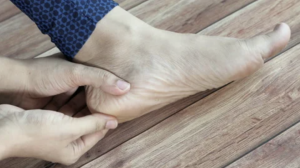Diabetic Foot Problems and Shoes
 American Diabetes Month is observed in November to promote awareness about diabetes and ways to manage it. Diabetes management includes taking care of the feet, which is important in avoiding serious foot complications. Continue reading to learn more about common foot problems and diabetic shoes available at Carmichael’s.
American Diabetes Month is observed in November to promote awareness about diabetes and ways to manage it. Diabetes management includes taking care of the feet, which is important in avoiding serious foot complications. Continue reading to learn more about common foot problems and diabetic shoes available at Carmichael’s.
What foot problems are associated with diabetes?
People with diabetes can develop various foot problems that may lead to serious complications. Here are the types of complications that can occur, according to the American Diabetes Association:
Nerve damage, also called Neuropathy. Diabetic nerve damage may cause a burning or stinging pain, tingling or weakness in the foot. It can decrease the ability to feel cold, heat and pain. With loss of feeling, you may not feel a blister or other foot injury until you notice broken skin or an infection. Nerve damage could also lead to changes in the shape of your feet and toes.
Skin Changes. Nerve damage additionally affects the body’s ability to retain moisture in the foot, which can cause dry skin that cracks and peels.
Calluses. People with diabetes are prone to having a buildup of calluses because of high-pressure areas under the foot. Calluses can turn into ulcers or open sores if not properly trimmed. This should be done by a health care professional. Having too many calluses requires a need for therapeutic shoes and inserts.
Poor Circulation. Diabetes causes blood vessels in the foot and leg to become narrow and harden, reducing blood flow. Poor circulation reduces the foot’s ability to fight infection and heal.
Foot Ulcers. Ulcers usually occur on the pad (ball) of the foot or on the bottom of the big toe. If neglected, ulcers can result in infections that can lead to loss of a limb.
Amputation. Many people with diabetes also have peripheral artery disease (PAD), which reduces blood flow to the feet, and neuropathy or loss of feeling. Together, these problems can cause infections and ulcers that may lead to amputation.
See your doctor right away if you notice any signs of foot problems. Follow these tips from the American Diabetes to take good care of your feet:
- Wash your feet thoroughly every day
- Dry them thoroughly, and don’t forget to dry between your toes
- Moisturize your feet, but avoid moisturizing between your toes
- Keep your toenails trimmed, and use an emery board to file down sharp edges
- Check your feet for sores, cuts, blisters, corns, or redness daily. Let your doctor know if you find any of these.
- Wear moisture-wicking socks
- Before putting your shoes on, check for sharp objects (such as small rocks)
- Wear shoes that fit well and don’t rub your feet
- Don’t walk around barefoot
- Don’t soak your feet
- Don’t smoke
Are there special shoes for diabetics?
A variety of comfortable athletic, casual and dress shoes from brands such as Dr. Comfort® and Orthofeet® are available at Carmichael’s retail locations. These shoes are designed to relieve calluses, hammertoes and other symptoms of foot problems associated with diabetes. A certified staff member can assist with the selection of proper shoes.
Does health insurance cover diabetic shoes?
Carmichael’s is committed to helping people with diabetes and other foot conditions remain active. In addition to several payment options available, we accept Medicare, Medicaid Healthy Louisiana (Bayou Health) and private insurance plans. Our billing specialists can check coverage and bill your insurance. Contact or visit us after a health care provider or specialist has checked your feet and recommended or prescribed diabetic shoes.




 Accredited/Certified by The Joint Commission
Accredited/Certified by The Joint Commission